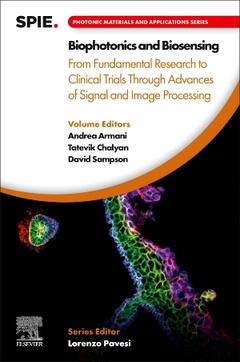Biophotonics and Biosensing From Fundamental Research to Clinical Trials Through Advances of Signal and Image Processing Photonic Materials and Applications Series
Coordonnateurs : Armani Andrea, Chalyan Tatevik, Sampson David

Biophotonics and Biosensing brings together the knowledge of the basic principles of the field of light?biological tissue interaction, detection methods, data processing techniques, and research, diagnostic, and clinical applications. It is suitable for new entrants to the field, while also highlighting the latest developments for experts. This volume includes perspectives by leading experts from the biophotonics and biosensing, biomedical engineering, and data science communities. The book provides a basic grounding in the key theoretical principles and practical components of biophotonics and biosensing. Working principles of devices used in spectroscopy, microscopy, and optical sensing are presented, along with their application domains. The reader will learn about existing microscopy-based techniques used in biomedical applications for diagnosis and get to know different signal- and image-processing algorithms, including the state of the art in artificial intelligence approaches, as used in biophotonics. Finally, the book describes through concrete examples, including sample preparation and measurement approaches, how the field has developed, thanks to the integration of biophotonics and optical biosensing with advanced signaland image-processing.
Section 1: Background and principles of biophotonics and optical biosensing 1. Tissue optics 2. Optical biosensors: working principles of optical biosensors, detection methods 3. Introduction to signal processing and data analysis methods Section 2. Microscopy techniques and optical biosensing in research, laboratory and clinical applications 4. Fluorescence microscopy 5. Raman spectroscopy-Research lab analytics 6. Metasurfaces for biomedical applications: Imaging and Sensing 7. Integrated photonics and Plasmonic biosensors 8. Fibre-based biosensors 9. Endo-microscopy 10. OCT-clinical studies Section 3. Advanced signal/image processing and data analysis methods for microscopy and sensing techniques 11. Innovations in signal/image processing and data analysis in optical microscopy 12. Innovations in signal/image processing and data analysis in Raman spectroscopy and imaging 13. Point-of-care biosensing systems 14. Innovations in signal/imaging processing and data analysis for OCT
Andrea Armani is jointly appointed at the Ellison Institute of Technology as the Senior Director of Physical Sciences and Engineering and at the University of Southern California as the Ray Irani Chair in Chemical Engineering and Materials Science. The overarching mission of her research is to develop nonlinear materials and integrated devices to advance microscopy and diagnostics. She is a Fellow of Optica, SPIE, NAI, and AAAS, and the impact of her work has been recognized by the World Economic Forum and others.
Tatevik Chalyan is a postdoctoral researcher in the Brussels Photonics Team at the Vrije Universiteit Brussel, Belgium. Her research interests cover the fields of biophotonics and optical biosensing. Her work focuses on the nanofabrication and development of plasmonic substrates for surface-enhanced Raman spectroscopy and fluorescence microscopy, as well as the study of microring resonators and interferometer-based biosensors for refractive index sensing, optofluidic design, and validation. Moreover, she is an Optica Ambassador.
David Sampson is Emeritus Professor at the University of Surrey and based in Perth, Western Australia. His overarching research interests are in the science and applications of light in medicine and biology, biomedical optics, and biophotonics. He is an authority in optical coherence tomography (OCT), with main interests in the microscope-in-a-needle (which targets surgical and biopsy guidance, for which he was awarded the IEEE Distinguished Lecturer Award and several other prizes), optical elastography (the micro-scale imaging of the mechanical properties of tissue), polarization-sensitive OCT and OCT angiography. His main application domains have been breast cancer, respiratory disease, and skin cancer. He is a fellow of AIMBE, IEEE, Optica, and SPIE.
- Introduces key principles of light-biological tissue interactions and biosensing
- Discusses how the most promising optical diagnostic methods can exploit contemporary signal and image processing algorithms and data analytics
- Includes examples of clinical studies with detailed descriptions of their implementation, along with practical guidance
Date de parution : 06-2024
Ouvrage de 550 p.
15.2x22.8 cm



